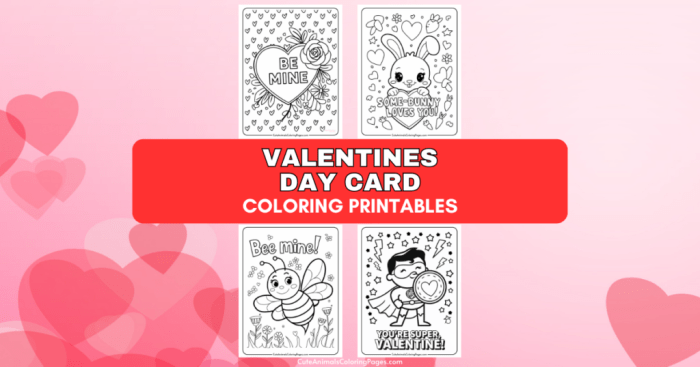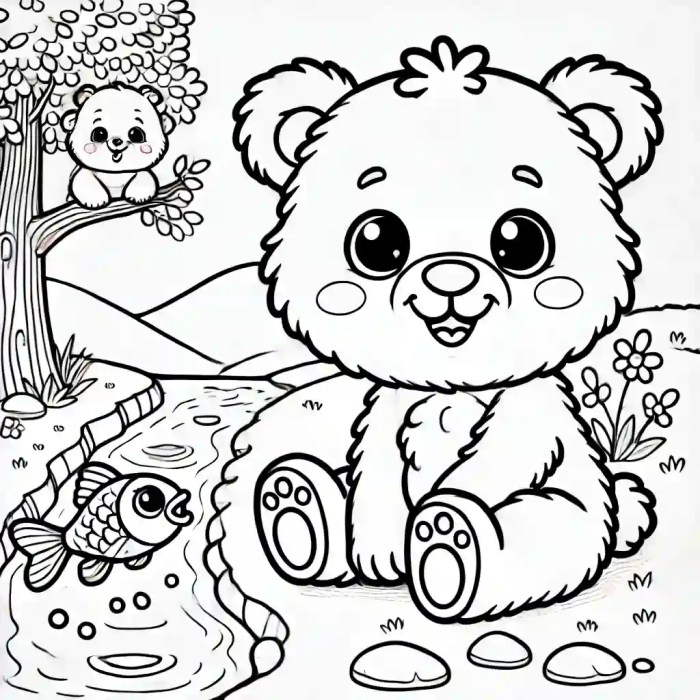Popular Animal Subjects in Coloring Pictures
Animal coloring pictures free – Free animal coloring pictures offer a delightful way to engage with the animal kingdom, fostering creativity and learning. From simple Artikels for toddlers to intricate designs for adults, these coloring pages cater to a wide range of skill levels and interests. The diversity of animal subjects ensures there’s something for everyone.
Common Animal Subjects Categorized, Animal coloring pictures free
Coloring pages feature a wide array of animals, spanning various classes and habitats. This diversity allows for exploration of different animal characteristics and environments. The following categories highlight some of the most popular animal subjects found in free coloring pictures.
- Mammals: Mammals are a popular choice due to their relatability and diversity. Lions are often depicted with flowing manes, emphasizing their regal nature. Elephants are frequently shown with large, expressive ears and gentle eyes. Horses are portrayed both realistically and in stylized, cartoonish forms, sometimes featuring long, flowing tails and dynamic poses. Dogs and cats are presented in various breeds, often with playful expressions and engaging poses.
- Birds: Birds offer a wide array of colors and patterns, making them attractive subjects for coloring. Owls are commonly depicted with large, forward-facing eyes and intricate feather details. Eagles are often shown in majestic poses, with outstretched wings and sharp talons. Peacocks are known for their vibrant tail feathers, which are often the focal point of the coloring page.
Parrots are depicted in a variety of bright colors and playful poses.
- Reptiles: Reptiles, with their unique textures and patterns, provide interesting coloring opportunities. Snakes are often shown coiled or slithering, with detailed scales. Turtles are depicted with patterned shells and calm expressions. Lizards are often shown in dynamic poses, highlighting their agility. Crocodiles are typically depicted with powerful jaws and textured skin.
- Amphibians: Amphibians, though less common than mammals or birds, offer unique coloring possibilities. Frogs are often depicted with bright colors and bulging eyes. Salamanders are shown with slender bodies and detailed skin patterns. Toads are often drawn with bumpy skin and wide mouths.
- Fish: Fish provide opportunities for exploring vibrant colors and underwater scenes. Clownfish are frequently depicted with their characteristic orange and white stripes. Sharks are often shown with sharp teeth and powerful bodies. Goldfish are portrayed with flowing fins and gentle expressions. Dolphins are often shown leaping out of the water in dynamic poses.
Free animal coloring pictures offer a relaxing creative outlet, but if you’re seeking something more adventurous, explore the detailed world of batman animated series coloring pages for a different kind of artistic fun. Afterward, return to the calming simplicity of animal coloring pages for a soothing change of pace.
- Insects: Insects, with their intricate details, offer a challenge for more advanced colorists. Butterflies are popular for their vibrant wing patterns and delicate bodies. Ladybugs are often shown with their characteristic red and black spots. Bees are depicted with fuzzy bodies and striped abdomens. Ants are often shown in busy scenes, carrying leaves or other objects.
Artistic Styles in Animal Coloring Pictures
Animal coloring pages showcase a variety of artistic styles, catering to different preferences and skill levels. Some pages feature simple Artikels, ideal for younger children developing their fine motor skills. These simple depictions often focus on basic shapes and recognizable features. Other pages offer detailed illustrations, allowing older children and adults to explore more intricate designs and shading techniques.
These detailed pages can be realistic, capturing the animal’s natural appearance, or cartoonish, emphasizing exaggerated features and playful expressions. Some coloring pages even incorporate stylized elements, such as geometric patterns or abstract designs, adding an artistic flair to the animal depictions.
Creating Engaging Animal Coloring Pages
Engaging animal coloring pages capture the beauty and wonder of the animal kingdom while providing a creative outlet. A well-designed coloring page can spark imagination and educate children about different species and their environments. Careful consideration of composition, detail, and the target audience ensures a captivating and enjoyable coloring experience.
Designing a Sloth Coloring Page
This coloring page will feature a three-toed sloth hanging from a cecropia tree branch in a lush rainforest. The sloth will be positioned centrally, its long claws gripping the branch realistically. The cecropia tree branch will have its characteristic large, palmate leaves. In the background, other rainforest elements will be included, such as vibrant heliconia flowers, philodendron leaves, and hanging vines.
A small, colorful toucan can be perched on a nearby branch, adding another element of rainforest life.
Steps to Create an Animal Coloring Page
Creating a compelling animal coloring page involves several steps from initial concept to the finished product. A structured approach ensures a polished and engaging result.
- Initial Sketch: Lightly sketch the animal and its environment with a pencil. Focus on the basic shapes and composition.
- Refine the Drawing: Add details to the animal and background elements. Consider the age of the target audience and adjust the complexity accordingly.
- Inking: Use a black pen or marker to Artikel the final drawing. Vary line thickness to create depth and emphasis.
- Erasing Pencil Marks: Gently erase any remaining pencil lines to create a clean image.
- Final Touches: Add texture or patterns to the animal’s fur or the background elements if desired.
Illustrating a Rainforest Scene
A rainforest scene offers a vibrant backdrop for a coloring page. This detailed illustration will bring the rainforest to life with a variety of animals and plants.The scene will depict a dense rainforest floor with tall, buttressed trees reaching towards the canopy. Sunlight filters through the leaves, creating dappled light on the forest floor. A family of monkeys, including a mother, father, and baby, swing from a thick vine.
A brightly colored macaw perches on a branch above them. On the forest floor, a jaguarundi cautiously stalks a green iguana near a patch of bromeliads. Large, vibrant butterflies, such as the blue morpho and the scarlet swallowtail, flutter among the foliage. Various plants will be included, such as ferns, orchids, and giant water lilies in a small pond.
The overall scene will be bustling with life, providing a rich and engaging coloring experience.
Incorporating Educational Elements: Animal Coloring Pictures Free

Coloring pages offer a unique opportunity to engage children in learning while fostering their creativity. By incorporating educational elements, these pages can transform a simple coloring activity into a valuable learning experience. This section explores how to effectively integrate educational content into animal coloring pages, enhancing their educational value.
Adding Educational Content to Animal Coloring Pages
Educational elements can seamlessly blend into the coloring page design. This can include short, factual descriptions about the animal, its habitat, diet, and unique characteristics. Incorporating these details not only educates the child but also adds context and meaning to the coloring activity. Additionally, interactive elements like matching games, word searches, or simple quizzes related to the animal can further enhance the learning experience.
Example Text Descriptions for a Specific Animal Coloring Page
Consider a coloring page featuring a red panda. The accompanying text could read: “The red panda, also called the lesser panda, is a small mammal native to the Eastern Himalayas and Southwestern China. Despite its name, it is not closely related to the giant panda. Red pandas are primarily herbivores, with bamboo making up a significant portion of their diet.
They are also known for their reddish-brown fur, long, bushy tails, and small, round ears.” This description provides basic information about the animal’s origin, diet, and physical characteristics.
Coloring Pages as a Tool for Animal Conservation
Coloring pages can be a powerful tool for introducing children to the importance of animal conservation. By featuring endangered animals and including information about the threats they face, these pages can raise awareness and inspire action. For instance, a coloring page featuring a snow leopard could include a short description about its dwindling population due to habitat loss and poaching.
This can spark a conversation about conservation efforts and encourage children to learn more about protecting endangered species. A simple call to action, such as “Learn more about how to help snow leopards,” can further empower children to get involved.
Different Coloring Techniques and Materials

Coloring animal pictures offers a creative and engaging activity for both children and adults. Exploring different coloring techniques and materials can significantly enhance the final artwork and provide a more fulfilling experience. Choosing the right materials and techniques depends on the desired effect and the complexity of the coloring page.
Suitable Coloring Materials
The following table presents various coloring materials suitable for animal coloring pages, outlining their descriptions, pros, and cons:
| Material | Description | Pros | Cons |
|---|---|---|---|
| Crayons | Wax-based sticks available in a wide range of colors. | Affordable, easy to use, vibrant colors. | Can be difficult to blend smoothly, may leave a waxy buildup. |
| Markers | Felt-tipped pens containing ink, offering bold and vibrant colors. | Intense colors, smooth application, good for covering large areas. | Can bleed through paper, may dry out quickly, less control for detailed work. |
| Colored Pencils | Wood-encased pencils with colored cores, allowing for detailed work and layering. | Precise application, blendable, allows for shading and layering. | Can be time-consuming for large areas, tips can break easily. |
| Watercolors | Pigments suspended in a water-based solution, offering a translucent and fluid effect. | Creates unique washes and blends, vibrant and subtle effects achievable. | Requires more control and practice, can be messy. |
Coloring Techniques
Different coloring techniques can add depth and dimension to animal coloring pages. Experimenting with these techniques can bring the artwork to life.* Blending: Smoothly transitioning between two or more colors creates a gradient effect. This technique can be achieved with colored pencils by layering colors and applying pressure variations, or with crayons by overlapping colors.
Shading
Adding darker tones to areas where light is less intense creates a three-dimensional appearance. This can be achieved by layering colors or using a darker shade of the same color.
Stippling
Creating small dots with a coloring tool to build up color and texture. This technique can be used with markers, pens, or colored pencils to create a unique and textured effect.
Selecting Appropriate Coloring Materials
Choosing the right coloring materials depends on the complexity and style of the coloring page. For intricate designs with fine details, colored pencils offer precision and control. For bold and vibrant images, markers are a suitable choice. Crayons are a versatile option for simpler designs and are ideal for younger children. Watercolors are best suited for creating washes and blended effects, particularly on thicker paper stock.
Consider the desired outcome and the level of detail required when selecting coloring materials.
